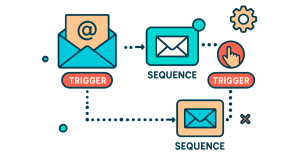To some, migrating all your data from your current marketing automation platform to a new one can be intimidating if not a full-on nightmare. That’s valuable information that your company has spent budget and time to collect and organize over the years, not to mention any content or workflows that your creative teams have put together.
When migrating goes wrong, this can lead to confusion and chaos which is why many are cautious when it comes to trying a new platform. However, with the right prep and partner, migration can be much less scary to navigate. It all comes down to having a full understanding of what needs to be migrated and executing a plan based on that.
Don’t worry if this still seems like a lot. We’re here to help guide you through it so that you walk away with a good migration experience!
Three Stages of Migration
We begin by presenting the WBS or the Work Breakdown Structure which we’ve created as a high-level overview of deliverables and assets for a migration project. This plan allows the breathing room to meet your current marketing objectives (we’re not about crisis moments of misaligned data or unexpected downtime) while also upgrading to your new marketing automation platform.
This process involves three key stages (Discovery, Setup, and Testing, Training & Launch) that the migration team will tackle from a general scope all the way down to granular tasks that will move your data along in the process. Being able to visualize the migration will play a beneficial role in creating a clear path towards tasks and responsibilities.

Discovery
The discovery phase is meant for just that — discovery. We’re trying to figure out what we currently have in our marketing automation database and getting it all organized to go on its migration journey. This is a great opportunity for a thorough audit where you can re-sort information in a way that makes sense, address any broken components, and delete duplicates.
Items that you will “discover” in this stage include sending domains, users and permissions, subscription methods and data sources, campaigns, templates, and lists. We include a full breakdown of this in our migration task checklist.
You’ll find yourself doing plenty of selecting, identifying, and reviewing during this phase. The information that’s there will dictate just how long it’ll take to sort through. If your company is the one switching platforms, these tasks will be assigned to your team. If you’re guiding a client through the process, it’ll be their side that needs to complete the sorting.
Setup
The setup stage will require the most work on your end. While an entire audit in the discovery stage may have seemed time-consuming and labor intensive, we’re not done with the bulk of the work yet! Having an organized process in place for setup will lead to a successful attempt at migration.
This stage combines the efforts of the marketing platform partner and you to get the job done. Expect to start from the very basics and work your way up from setting up the account to setting up users and permissions, and eventually setting up any ongoing campaigns. You put in a lot of work when organizing your data, now is the time to make sure everything gets moved over properly.
Key tasks that fall under this stage include account setup, email authentication setup, asset transfer, dedicated sending IP setup, campaign setup, and integrations and data sync setup. We include each of the individual subtasks involved with these in our checklist so there’s no need to be overwhelmed. Together, we’ll make it to the last stage of migration!
Testing, Training and Launch
Once everything has been moved, created, and settled, you’ll get a chance to play around in your new marketing platform. Get ready to learn a lot because this last stage of the process is centered around testing your data and training users in the new platform. You’ll be walked through features and how they work as well as ways you can leverage the platform and your data to achieve some pretty cool marketing feats. This gives you all the tools needed to understand the most advantageous ways to utilize your new marketing automation platform.
When you have the groundwork laid out, you’re ready to launch the first of many campaigns.
Remember that many platforms are continuously updating their technology so you and your team will end up being very familiar with this stage. As you train new team members or work through new features, a training and testing refresher allows you to maximize the capabilities of the platform. It’s also a great way to reinforce information across the board even for those who have had extensive experience working in the software.
Some Tips to Keep Things Flowing Smoothly
There are many aspects to keep track of as you get started. Beyond your checklist, there are several things to keep in mind that will ensure you’re being thorough, efficient, and proactive.
First off, be sure to define your business goals. This is something that everyone on the team should be conscious of especially if it is something that is driving your need for a new marketing automation platform. The success of your migration project and future marketing automation abilities rests on identifying the functions and features that your new investment brings to the table.
With a new platform comes new responsibilities. Be sure to know who is in charge of what during the migration. Some tasks you’re able to manage on your own while others may need to be completed by other team members before you’re able to do anything on your end. Assigning roles and expectations ahead of time will help keep everyone on track and well-informed of exactly what should be happening and who should be making it happen.
With this also comes setting new internal expectations. Before you even dive into the new platform, it’s a good idea to determine how things will be done from naming conventions and folder structures to any new processes that may need to be implemented. Additional potential roadblocks to consider include aligning your sales and marketing processes and teams, reporting, and data governance (who owns what and what data should sync bidirectionally).
Finally, find a stellar partner to go through the process with. The effectiveness of a marketing platform doesn’t rely solely on the prowess of the software but also the expertise and dedication of the team that created it. A good partner will not only guide you through the process but also provide invaluable support beyond the tasks of the migration. Here at emfluence, we guarantee a smooth process with custom onboarding, two hours of one-on-one training, data migration, unlimited support and more.
The Takeaway
It is no lie that migrating to new software is a big process for an organization to undertake and timelines are unique depending on the teams behind them. However, it doesn’t need to leave you overly stressed and worrying even outside of work hours. If you’re willing to take the time to walk through all the considerations and perform each task with intention, you’ll find that the return on investment is well worth it.
Looking for a new marketing automation platform? Contact us at expert@emfluence.com or request a demo to learn more about the emfluence Marketing Platform today!


